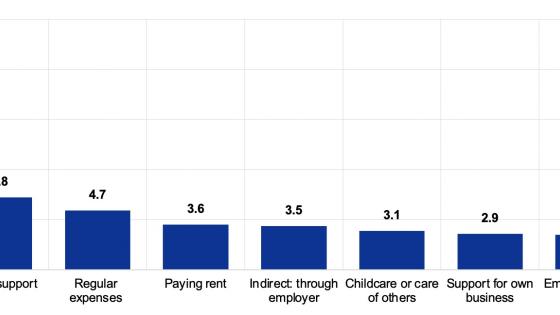Editor's note: This is the first of four columns sharing reflections on the recent IMF conference “Rethinking Macro Policy II: First Steps and Early Lessons”.
I learned a lot from the IMF’s recent conference on rethinking macroeconomic policy (IMF 2013), and I’m very thankful to all the speakers. Do I have an image of the whole thing? I don’t know whether my image is going to help anybody at all, but my view is that it’s as if a cat has climbed a huge tree. It’s up there, and oh my God, we have this cat up there. The cat, of course, is this huge crisis. And everybody at the conference has been commenting about what we should do about this stupid cat and how do we get it down. What I find so wonderful about this conference is all the speakers have their own respective image of the cat, and nobody has the same opinion. But then, occasionally, those opinions mesh. That’s my image of what we have been accomplishing. I think this debate is very useful because each person’s view of the cat comes from his or her perspective. And each of them is valid. My view of the cat is the poor thing is there in the tree; it’s going to fall; and we don’t know what to do.
My own thoughts
So I’m going to give you my own thoughts on the crisis and how well we’ve been doing relative to the cat. My thoughts are a slightly different angle on what everybody else has been saying rather pervasively from different vantage points.
I am going to concentrate on the post-crisis US, but the analysis also pertains internationally. There is an excellent paper by Oscar Jorda, Morris Schularick and Alan Taylor (2011). They divided up recessions into financial recessions and normal recessions for fourteen advanced countries from 1870 to 2008. They looked at how GDP recovery varied in severity, according to credit outstanding relative to GDP in the preceding boom. And their conjecture was strongly confirmed:
- Not only are financial recessions deeper and slower in recovery than in normal recessions, they also have slower recovery the greater is the credit-to-GDP ratio;
That is the history. How do their findings reflect on the current crisis? Curiously, it depends upon the measurement of credit outstanding:
- With bank loans to the private sector as the measure of credit, the US recovery is about 1% of GDP better than mean recovery for financial recessions;
- When, in addition, the measure of credit also includes credit granted by the shadow banking system, we are about 4% better than the median recovery in financial recessions;
The graphs in the paper I just mentioned illustrate this, but with the onset of financial derivatives we have no way of knowing how to measure ‘credit’.
If derivatives are used to hedge risk then we would expect derivatives to soften the crash. For example if the buyer of a credit default swap goes bankrupt in the event of a default, rather than the seller, then we would expect the credit default swap to soften the crash. On the other hand, if we think that derivatives escalate gambling, then we would expect them to exacerbate the crash.
The conventional interpretation of the 2007-2008 crash in the US says that derivatives enhanced gambling in a different way. In parable, derivatives allowed a daisy chain of escalating valuation of mortgages, as they were made in the Central Valley on the shadiest of bases, but then passed through into derivative packages, which were rated A and higher. This was an environment in which junk did not affect ratings. So mortgage originators had no incentive to require down payments or borrower credibility. To a great extent, they didn’t.
In their creation and ratings of derivatives the investment houses and the ratings agencies were mining their reputations as fiduciaries. This additional role of the derivatives suggests that a measure of credit based on loans outstanding, even including the role of the shadow banks, yields a conservative measure of our benchmark for where we should now be.
Today’s policy response looks good compared to the Great Depression
That view also conforms to the common perceptions from autumn 2008. At that time the Great Depression was the benchmark for what would happen without government intervention. From that vantage point, macro policy has not just been good, but truly excellent. Alan Blinder’s fantastic book, After the Music Stopped, says the exact same thing.
Almost every programme has been close to what the doctor called for. Those measures include: the Economic Stimulus Act of 2008; the bailout of AIG; the rescue of WaMu, Wachovia and Countrywide by adoption; the Troubled Asset Relief Programme; the stress tests run by Treasury and the Fed; declines in interest rates to close to zero; the American Recovery and Reinvestment Act of 2009; the bailout of the auto industry; and international co-operation in the spirit of the G20 Meeting in Pittsburgh in which the IMF played a leading role.
There is only one major criticism of the policies put in place:
- We should have led the public to understand that we should measure success not by the level of the current unemployment rate, but by a benchmark that takes into account the financial vulnerability that had been set in the previous boom;
We economists have not done a good job of explaining that our macro-stability policies have been effective. There is, of course, good reason why the public has a hard time listening. They have other things to do than to become macroeconomists and macroeconomic historians.
But just a bit of common sense indicates why the policies have been so successful. If Lehman Brothers had been $1 in the red, and it needed to be only $1 in the black to stay out of bankruptcy court, then the expenditure of only $2, at just the right crisis moment, could have saved us from a Great Depression. That $2 finger in the dyke would have been all that was needed.
The expenditures for the bailout were of course more than $2; they will probably be positive, and run to a few billion dollars. But they did, literally, stop a financial meltdown that was in progress. Relative to the tens of trillions of GDP that would have been lost with a repeat of the Great Depression, the savings from the Troubled Asset Relief Program are of the order of magnitude of a thousand to one. A thousand to one says that, figuratively, it may be fair to call this a finger in the dyke.
The expenditures by both the Bush and the Obama administrations on fiscal stimulus have had less bang-for-the-buck. But almost surely they have been effective. Current estimates of government expenditure multipliers are something like two. That number also makes intuitive sense. Liquidity-trap estimates of a balanced budget multiplier are approximately one, both in theory and in estimation; and the tax multiplier is robustly measured as approximately one. The government expenditure multipliers will be the sum of the two, so the stimulus bills have almost surely also had significant payoff.
Conclusions
In sum, we economists did very badly in predicting the crisis. But the economic policies post-crisis have been close to what a good, sensible ‘economist-doctor’ would have ordered. Those policies have come directly from the Bush and Obama administrations, and from their appointees. They have also been supported by the Congress.
The lesson for the future is that good economics and common sense have worked well. We have had trial and success. We must keep this in mind with policy going forward.
Editor’s note: This was first posted on iMFdirect; reposted with permission.
References
Blinder, Alan S (2013), After The Music Stopped, Penguin.
IMF (2013), “Rethinking Macro Policy II: First Steps and Early Lessons”, conference, 16-17 April.
Jorda, Oscar, Morris Schularick and Alan Taylor (2011), “When credit bites back: Leverage, Business Cycles and Crises”, NBER Working Paper Series 17621, NBER.


